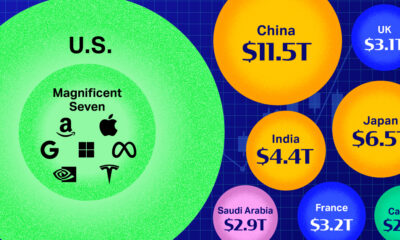Technology
Tap Into the Mobile Payments Revolution

Tap Into the Mobile Payments Revolution
The trends and contenders that are shaping mobile payments.
Thanks to Purefunds Mobile Payments ETF (IPAY) for helping us put this together.
Yesterday, user-friendly payment processor Stripe announced a strategic investment and partnership from Visa that values the company at $5 billion. Other investors that participated are not unknowns either: Kleiner Perkins Caufield Byers, American Express, and Sequoia. It was only in December that Stripe was valued at $3.5 billion and in their previous financing, they were valued at just half of that. Stripe will use Visa’s international connections to help it expand beyond the 20 countries it currently services.
This type of story is not unusual in the payment space. Companies are scrambling to scale or adopt new technologies that integrate mobile and electronic features to make it easier, cheaper, and faster for customers to pay. The reason for this is that the payments ecosystem has always been more cumbersome and more expensive than it should be. In the United States alone, retail merchants that accept card-based payments were charged about $67 billion in fees. Add the rest of the world to that pie, and it makes it clear that the payments space is as ripe for disruption as any other.
Mobile and electronic payments allow customers to pay for goods with a tap of a phone or the press of a button. Two of every three Americans have a smartphone, and mobile payments can typically happen faster with less fees. The earliest adopters of mobile payments have a younger and affluent profile: they average just over 30 years old, have a higher annual income, and spend over 2x more on retail than unwilling non-users of mobile payments.
Big Data and the Developing World
One of the most attractive benefits of mobile payments is the integration of big data and predictive analytics. Retailers will have the capability to link purchases directly with location (GPS), consumer behaviour, purchase history, demographics, and social influence. Analyzing this information will allow companies to reach out to consumers with tailored offerings, loyalty programs, and rewards. Customers will be able to take action right from their mobile device.
The opportunities in payments are not just limited to in the United States or even the developed world. Perhaps one of the most interesting opportunities for the mobile payments space is in Africa, where bank penetration is extremely low at only about 25% and mobile phone penetration is higher at 60%. Kenya is a good example of a market where digitization has reached a large portion of the population, giving mobile payments an 86% household penetration.
Mckinsey did an analysis looking at the size of revenue pools for mobile payments if each market in Africa had the same penetration as Kenya, and it sees the pools more than doubling in places like Ethiopia and Nigeria. With the population in sub-Saharan Africa expected to balloon from 926 million to 2.2 billion by 2050, their appears to be even greater opportunity.
Tapping In
The earliest potential in the mobile and electronic payments market appears to be in areas such as micropayments, incidental payments, recurring bills, peer-to-peer money transfers, and cryptocurrency. However, in the long term, the concept can be applied to many different facets of commerce.
Mobile payments may continue to disrupt the big payments market because of several factors including a young and growing userbase, ease of use, faster transactions, cheaper costs, and increased adoption. As Smittipon Srethapramote, who covers the North American payments industry for Morgan Stanley, concludes in a summary on the subject: “Mobile Payments can expand the global revenue pie from $175 billion to $250 billion, including $45 billion in developed markets and $30 billion in emerging markets.”
Technology
Ranked: Semiconductor Companies by Industry Revenue Share
Nvidia is coming for Intel’s crown. Samsung is losing ground. AI is transforming the space. We break down revenue for semiconductor companies.
Semiconductor Companies by Industry Revenue Share
This was originally posted on our Voronoi app. Download the app for free on Apple or Android and discover incredible data-driven charts from a variety of trusted sources.
Did you know that some computer chips are now retailing for the price of a new BMW?
As computers invade nearly every sphere of life, so too have the chips that power them, raising the revenues of the businesses dedicated to designing them.
But how did various chipmakers measure against each other last year?
We rank the biggest semiconductor companies by their percentage share of the industry’s revenues in 2023, using data from Omdia research.
Which Chip Company Made the Most Money in 2023?
Market leader and industry-defining veteran Intel still holds the crown for the most revenue in the sector, crossing $50 billion in 2023, or 10% of the broader industry’s topline.
All is not well at Intel, however, with the company’s stock price down over 20% year-to-date after it revealed billion-dollar losses in its foundry business.
| Rank | Company | 2023 Revenue | % of Industry Revenue |
|---|---|---|---|
| 1 | Intel | $51B | 9.4% |
| 2 | NVIDIA | $49B | 9.0% |
| 3 | Samsung Electronics | $44B | 8.1% |
| 4 | Qualcomm | $31B | 5.7% |
| 5 | Broadcom | $28B | 5.2% |
| 6 | SK Hynix | $24B | 4.4% |
| 7 | AMD | $22B | 4.1% |
| 8 | Apple | $19B | 3.4% |
| 9 | Infineon Tech | $17B | 3.2% |
| 10 | STMicroelectronics | $17B | 3.2% |
| 11 | Texas Instruments | $17B | 3.1% |
| 12 | Micron Technology | $16B | 2.9% |
| 13 | MediaTek | $14B | 2.6% |
| 14 | NXP | $13B | 2.4% |
| 15 | Analog Devices | $12B | 2.2% |
| 16 | Renesas Electronics Corporation | $11B | 1.9% |
| 17 | Sony Semiconductor Solutions Corporation | $10B | 1.9% |
| 18 | Microchip Technology | $8B | 1.5% |
| 19 | Onsemi | $8B | 1.4% |
| 20 | KIOXIA Corporation | $7B | 1.3% |
| N/A | Others | $126B | 23.2% |
| N/A | Total | $545B | 100% |
Note: Figures are rounded. Totals and percentages may not sum to 100.
Meanwhile, Nvidia is very close to overtaking Intel, after declaring $49 billion of topline revenue for 2023. This is more than double its 2022 revenue ($21 billion), increasing its share of industry revenues to 9%.
Nvidia’s meteoric rise has gotten a huge thumbs-up from investors. It became a trillion dollar stock last year, and broke the single-day gain record for market capitalization this year.
Other chipmakers haven’t been as successful. Out of the top 20 semiconductor companies by revenue, 12 did not match their 2022 revenues, including big names like Intel, Samsung, and AMD.
The Many Different Types of Chipmakers
All of these companies may belong to the same industry, but they don’t focus on the same niche.
According to Investopedia, there are four major types of chips, depending on their functionality: microprocessors, memory chips, standard chips, and complex systems on a chip.
Nvidia’s core business was once GPUs for computers (graphics processing units), but in recent years this has drastically shifted towards microprocessors for analytics and AI.
These specialized chips seem to be where the majority of growth is occurring within the sector. For example, companies that are largely in the memory segment—Samsung, SK Hynix, and Micron Technology—saw peak revenues in the mid-2010s.
-

 Real Estate2 weeks ago
Real Estate2 weeks agoVisualizing America’s Shortage of Affordable Homes
-

 Technology1 week ago
Technology1 week agoRanked: Semiconductor Companies by Industry Revenue Share
-

 Money1 week ago
Money1 week agoWhich States Have the Highest Minimum Wage in America?
-

 Real Estate1 week ago
Real Estate1 week agoRanked: The Most Valuable Housing Markets in America
-

 Business2 weeks ago
Business2 weeks agoCharted: Big Four Market Share by S&P 500 Audits
-

 AI2 weeks ago
AI2 weeks agoThe Stock Performance of U.S. Chipmakers So Far in 2024
-

 Misc2 weeks ago
Misc2 weeks agoAlmost Every EV Stock is Down After Q1 2024
-

 Money2 weeks ago
Money2 weeks agoWhere Does One U.S. Tax Dollar Go?














